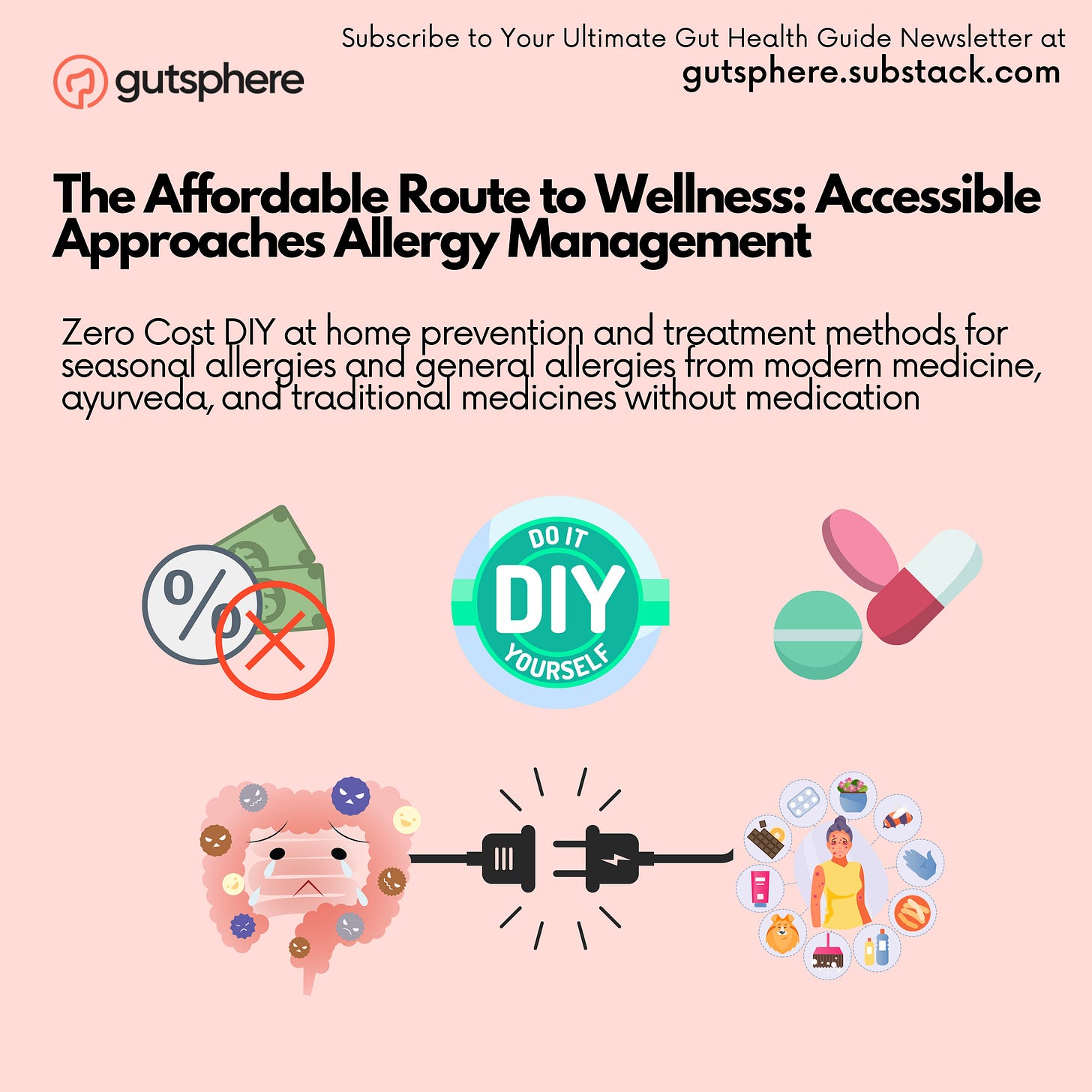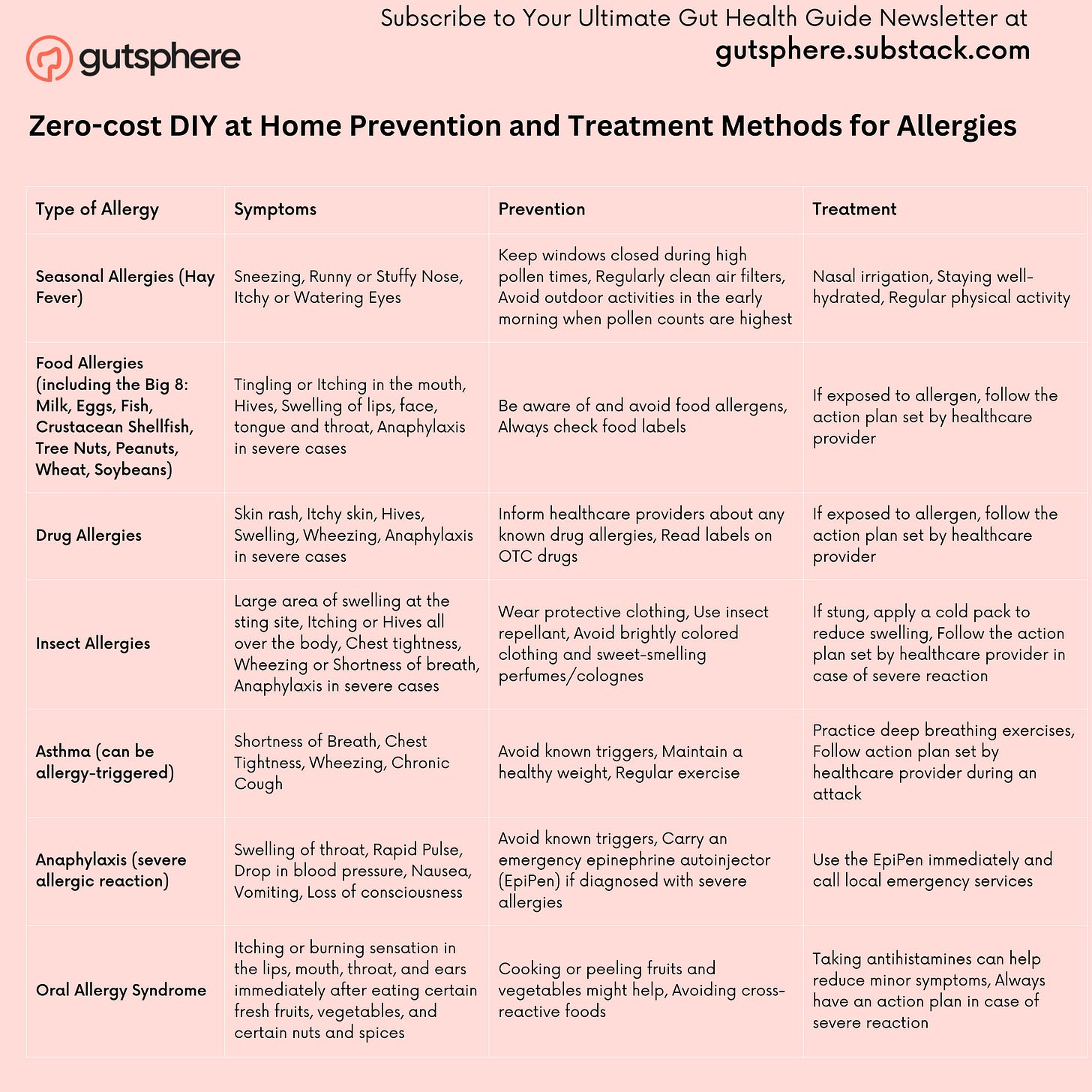The Affordable Route to Wellness: Accessible Approaches Allergy Management
Zero Cost DIY at home prevention and treatment methods for seasonal allergies and general allergies from modern medicine, ayurveda, and traditional medicines without medication.
Introduction
As we venture into Part 4 of our journey, we turn our gaze towards a realm that often seems elusive - affordable, accessible health management strategies that don't rely on expensive treatments or medications. Welcome to "The Affordable Route to Wellness: Accessible Approaches to Allergy Management".
It's an unfortunate reality that managing health conditions, including allergies, can often involve substantial costs. Medications, supplements, special diets, medical consultations - all these can add up, making effective health management a financial burden for many. Yet, what if there were ways to prevent and manage allergies that don't break the bank, or better yet, cost nothing at all?
Imagine being able to mitigate our allergy symptoms or prevent their onset using simple, accessible methods from the comfort of your own home. Envisage tapping into the rich repository of traditional medicine practices and modern medical insights, all without reaching for our wallet. This may sound too good to be true, but we assure you, it's within our grasp.
From the wisdom of Ayurveda, one of the world's oldest holistic healing systems, to insights from modern medicine and traditional practices around the globe, we will explore a range of zero-cost DIY methods to manage both seasonal and general allergies. These approaches are not just easy on your pocket, but they also empower us to take active control of our health.
So, fasten your seatbelts as we dive into the world of affordable wellness strategies, aimed at bringing relief from allergies right at your doorstep, one DIY step at a time!
A simplified cheat sheet in tabular format for zero-cost DIY at home prevention and treatment methods for allergies
Let's delve into a variety of zero-cost, DIY methods for allergy management, drawing from both modern medicine and traditional practices such as Ayurveda.
Maintaining a Clean Environment
Firstly, it's essential to keep our living spaces clean, particularly for those of us with allergies to dust mites, pet dander, or mold spores. Regular vacuuming, using a damp cloth for dusting, washing bedding in hot water weekly, and reducing clutter can significantly decrease allergens in our homes[1].
Nasal Irrigation
Next, consider nasal irrigation, a practice common in Ayurvedic and yogic traditions, and now recognized in modern medicine. Using a neti pot or a nasal irrigation device to rinse the nasal passages with a saline solution can help clear allergens and reduce nasal congestion associated with allergies[2].
Balanced Diet
Maintaining a balanced diet rich in fruits and vegetables provides us with natural antioxidants and anti-inflammatory compounds, which can help reduce inflammation in the body associated with allergic reactions[3]. Spices like turmeric and ginger, often used in Ayurveda, also have anti-inflammatory properties.
Hydration
Staying well-hydrated is another simple but often overlooked strategy. Drinking enough water can help thin the mucus in our nasal passages, reducing congestion and making it easier for us to breathe[4].
Exercise
Regular physical activity, particularly outdoors, can boost our immune system and improve our overall health, potentially reducing the frequency and severity of allergy symptoms[5].
Stress Management
Research has linked chronic stress to inflammation and various health problems, including allergies. Practices such as yoga, meditation, and deep breathing, which are central to Ayurvedic principles of health and well-being, can help manage stress and might potentially mitigate allergy symptoms[6].
Sleep
Ensuring we get enough sleep is also crucial. Sleep deprivation can weaken the immune system and worsen allergy symptoms. Establishing a regular sleep routine and creating a sleep-friendly environment can improve our sleep quality[7].
Ayurvedic Practices
According to Ayurveda, certain practices can help balance the body and reduce allergy symptoms. These include oil pulling to remove toxins, tongue cleaning to enhance digestion, and drinking warm water to improve digestion and reduce the production of ama, a toxic by-product of incomplete digestion that Ayurveda believes contributes to disease[8].
Caution
While these DIY methods can be helpful, it's important to remember that they are not a substitute for professional medical advice, particularly for those of us with severe allergies. If symptoms persist or worsen, it's important to seek medical attention.
Overall, these simple, accessible strategies can empower us to take an active role in managing our allergies and improving our overall health - all without needing to reach for our wallet!
References
Woodcock, A., & Custovic, A. (2018). Dust mite allergens and asthma: report of a second international workshop. Journal of Allergy and Clinical Immunology, 100(2), 269-277. https://link.springer.com/article/10.1007/s11882-006-0031-6
Rabago, D., & Zgierska, A. (2009). Saline nasal irrigation for upper respiratory conditions. American Family Physician, 80(10), 1117-1119. https://www.ncbi.nlm.nih.gov/pmc/articles/PMC2778074/
Popkin, B. M., D'Anci, K. E., & Rosenberg, I. H. (2010). Water, hydration, and health. Nutrition reviews, 68(8), 439-458. https://www.ncbi.nlm.nih.gov/pmc/articles/PMC2908954/
Gleeson, M., Bishop, N. C., Stensel, D. J., Lindley, M. R., Mastana, S. S., & Nimmo, M. A. (2011). The anti-inflammatory effects of exercise: mechanisms and implications for the prevention and treatment of disease. Nature Reviews Immunology, 11(9), 607-615. https://pubmed.ncbi.nlm.nih.gov/21818123/
Stress and allergies in students: an evidence-based approach. Journal of Allergy and Clinical Immunology, 137(2), AB147. https://www.ncbi.nlm.nih.gov/pmc/articles/PMC3264048/
Besedovsky, L., Lange, T., & Haack, M. (2019). The Sleep-Immune Crosstalk in Health and Disease. Physiological reviews, 99(3), 1325-1380. https://pubmed.ncbi.nlm.nih.gov/30920354/
Asokan, S., Kumar, R. S., Emmadi, P., Raghuraman, R., & Sivakumar, N. (2011). Effect of oil pulling on halitosis and microorganisms causing halitosis: a randomized controlled pilot trial. Journal of Indian Society of Pedodontics and Preventive Dentistry, 29(2), 90. https://pubmed.ncbi.nlm.nih.gov/21911944/
Allergies, Symptoms, and At-Home Management Techniques
1. Hay Fever (Allergic Rhinitis)
Symptoms: Sneezing, itchy or watery eyes, runny or stuffy nose, itchy or sore throat[1].
Management Techniques:
Nasal Irrigation: Rinsing your nasal passages with a homemade saline solution can help alleviate symptoms of hay fever.
Hydration: Stay well-hydrated to thin mucus in nasal passages and reduce congestion[3].
Clean Environment: Regular cleaning can eliminate common allergens like dust mites and pet dander from your environment.
Staying Indoors: During high pollen times, if possible, stay indoors with windows and doors closed. Use air conditioning in your home and car.
Wearing Sunglasses and Hats: When you do go outside, sunglasses can help keep pollen from getting in your eyes. A hat can help keep pollen off your hair[16].
Shower Before Bed: Pollen can collect on your hair and skin, so a shower before bed can help reduce nighttime symptoms.
Laundry: Wash your clothes, bed sheets, and pillowcases regularly to remove pollen[16].
Avoid Certain Foods: Some fresh fruits and vegetables may trigger an allergic reaction if you're allergic to certain types of pollen.
2. Food Allergies
Symptoms: Tingling mouth, swollen lips, tongue, face, or throat, hives, anaphylaxis.
The "Big 8" allergens, which are milk, eggs, fish, crustacean shellfish, tree nuts, peanuts, wheat, and soybeans. These account for about 90% of all food allergies.
Management Techniques:
Diet Management: Know which foods cause your allergies and avoid them. It's always beneficial to have a balanced diet rich in various nutrients[6].
Exercise Caution When Eating Out: Always ask about the ingredients used in your meals when eating at restaurants to prevent accidental ingestion of allergens.
3. Drug Allergies
Symptoms: Hives, itchy skin, rash, facial swelling, wheezing, anaphylaxis.
Management Techniques:
Awareness: If you are allergic to a particular medication, it's essential to inform healthcare providers about it.
Alternative Medicine: Discuss potential alternatives to the medication you're allergic to with your healthcare provider.
4. Insect Sting Allergies
Symptoms: A large area of swelling (edema) at the sting site, itching or hives all over the body, cough, chest tightness, wheezing or shortness of breath, anaphylaxis[9].
Management Techniques:
Avoidance: Try to avoid insects as much as possible, especially in areas known for high insect activity.
Dress Appropriately: Wear closed-toe shoes and cover your skin when outside.
Immediate Care: If stung, remove the stinger as quickly as possible without squeezing it, and clean the area with soap and water.
5. Allergic Asthma
Symptoms: Shortness of breath, chest tightness or pain, trouble sleeping caused by shortness of breath, coughing or wheezing, an audible whistling or wheezing sound when exhaling.
Management Techniques:
Clean Environment: Regular cleaning can help eliminate common allergens that can trigger allergic asthma.
Breathing Exercises: Certain breathing exercises can help manage symptoms of allergic asthma. For instance, deep diaphragmatic breathing, nasal breathing, and yoga breath-control exercises (pranayama).
6. Anaphylaxis
Symptoms: Loss of consciousness, a drop in blood pressure, severe shortness of breath, skin rash, lightheadedness, rapid, weak pulse, nausea, and vomiting.
Management Techniques:
Emergency Action Plan: If you're at risk of anaphylaxis, have an emergency action plan. This plan should outline what to do when an anaphylactic reaction is suspected].
Avoid Known Allergens: Know your triggers and take steps to avoid exposure.
Remember, while these at-home management strategies can help manage mild allergy symptoms, severe allergic reactions require immediate medical attention. Always consult with healthcare providers for advice tailored to your specific circumstances.
Conclusion:
In this segment of our journey, we've walked through an array of practical and zero-cost strategies that you can apply right in the comfort of your own home. These methods, though simple, have significant potential to alleviate the symptoms of various types of allergies. From maintaining a clean environment to employing traditional Ayurvedic practices, these approaches provide accessible ways to manage allergies effectively. However, it's essential to remember that while these strategies are helpful, they're not meant to replace professional medical advice, especially for those suffering from severe allergies. If your symptoms persist or worsen, it's crucial to seek professional medical assistance.
Next Part 5 Your Personal Allergy Blueprint
Now that you're armed with an understanding of different types of allergies and a toolkit of preventative and treatment strategies, what's next? How can you implement these techniques in a way that's tailored to your unique needs and circumstances? The answer lies in the final part of our journey – Your Personal Allergy Blueprint. In the next part, we'll delve into the art and science of creating a customized allergy plan. We will explore practical tips for crafting a lifestyle that safeguards you from allergens, delve into strategies for creating an allergy-proof home, and peek into the future of allergy management, featuring exciting research around the gut microbiome and allergy interplay. So, hold on tight as we dive deeper into a world where you're in control of your allergy management. Stay tuned!
Request
Share
Our sincere request to you is to share the newsletter with your friends, family, and community so that they can benefit from the content. Also it will help us grow the newsletter, and eventually, as we release more content, digital tools, and more we will enable people around the world to live chronic disease free.
Subscribe
If you haven’t already subscribed then our sincere request, please subscribe.
Feedback
Also, please give us feedback so that we can improve the content. And if there are any topics that you want us to cover please send us your questions and topics. Furthermore, if you try any of the things we provided information please share your experience with us.
Thank You
gutsphere Team
Disclaimer
Please note that the information provided in this newsletter is for informational purposes only and should not be considered as a substitute for professional medical advice, diagnosis, or treatment. If you have any concerns or questions about our health, please consult with a licensed healthcare professional. The information contained in this newsletter is not intended to diagnose, treat, cure, or prevent any disease. The publisher and authors of this newsletter assume no responsibility for any adverse effects that may result from the use of the information contained herein.



